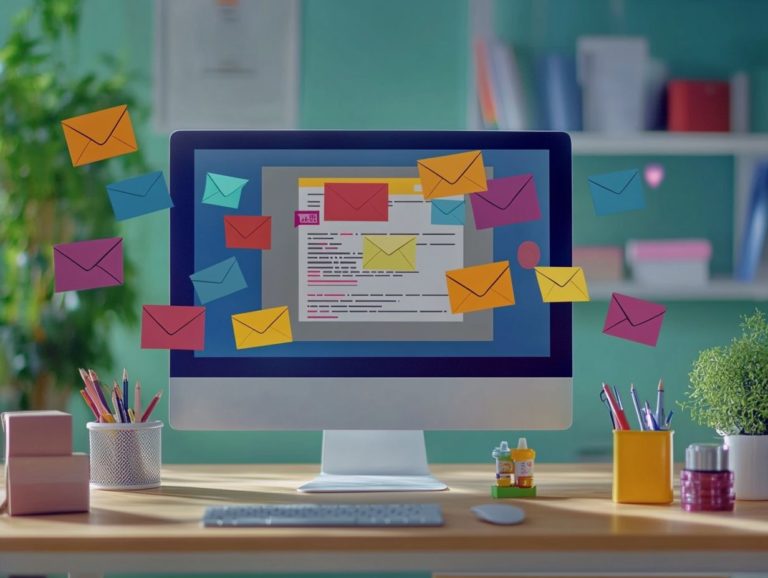How to Segment Your Email List Effectively
Let's Set Up Your Lead Generation Strategy
Fill out the form below, and our team will get in touch with you to create a tailored solution for your business.
Email marketing has the potential to revolutionize your business, but without effective list segmentation, your efforts may not yield the desired results.
By tailoring your messages to specific audience segments, you can significantly enhance engagement and drive conversions. This article delves into the critical importance of email list segmentation and its profound impact on your marketing success.
You ll explore various segmentation types like demographic, behavioral, and psychographic and discover best practices for implementation, along with the right tools to utilize. This guide equips you to create targeted campaigns that resonate with your audience.
It also highlights key metrics to measure your success and outlines common pitfalls to steer clear of. Get ready to supercharge your email strategy!
Contents
- Key Takeaways:
- Why Email List Segmentation is a Game Changer for Your Business
- Types of Email List Segmentation
- Let's Set Up Your Lead Generation Strategy
- Best Practices for Effective Segmentation
- Tools and Strategies for Segmenting Your Email List
- Measuring the Success of Email List Segmentation
- Let's Set Up Your Lead Generation Strategy
- Common Mistakes to Avoid
- Frequently Asked Questions
- Let's Set Up Your Lead Generation Strategy
Key Takeaways:

- To succeed in email marketing, you must segment your list effectively!
- Use various criteria, like demographics, behavior, and psychology, to segment your list.
- Utilize tools like email marketing platforms and personalization techniques to segment your list and measure success through key metrics.
Why Email List Segmentation is a Game Changer for Your Business
Email list segmentation is an essential strategy in email marketing that enables you to refine your communication with specific audience segments. This approach can significantly enhance key performance metrics like open rates, click-through rates, and unsubscribe rates.
By implementing targeted email campaigns through effective segmentation, you not only nurture customer loyalty but also improve your ability to generate leads that are likely to buy. This practice is especially advantageous for platforms like MemberPress, where a keen understanding of user needs allows you to craft tailored messages that resonate more profoundly with potential customers.
Why It Matters for Email Marketing Success
Effective email marketing relies on your ability to connect with the right audience through relevant content, making segmentation a vital strategy for enhancing customer retention and email engagement throughout the sales funnel.
When you customize messages based on demographics, purchase history, or engagement levels, you create a personalized experience that truly resonates with your recipients. For example, a prominent e-commerce brand experienced a remarkable 30% increase in open rates after implementing segmentation strategies, which subsequently led to an impressive 25% boost in their click-through rates.
Research shows that companies employing targeted segmentation enjoy up to 50% lower unsubscribe rates compared to generic mass emails. This means that when your content aligns with a customer s interests, they are significantly more likely to stay engaged and loyal, ultimately resulting in higher conversion rates and sustained brand loyalty.
Types of Email List Segmentation
Email list segmentation can be divided into various types, such as demographic segmentation, geographic segmentation, and behavioral segmentation. Each of these approaches allows you to tailor your communication based on distinct customer characteristics and purchasing behaviors.
By harnessing these segmentation strategies, you can craft more personalized and impactful email campaigns that resonate with your target audience.
Demographic, Behavioral, and Psychographic
Demographic, behavioral, and psychographic segmentation are your three essential strategies for maximizing email engagement by aligning content with the unique preferences and characteristics of various audience segments.
By categorizing your subscribers based on factors like age, gender, income, interests, and online behaviors, you can tailor messages that resonate more deeply with each recipient. For example, demographic segmentation could inspire you to send targeted promotions for outdoor gear to younger customers who have expressed an interest in hiking, likely boosting both your open and click-through rates.
Similarly, using behavioral segmentation allows you to analyze past purchase behavior to recommend related products, enhancing the relevance of every email you send. Meanwhile, psychographic segmentation dives into lifestyle choices, values, and personality traits, enabling you to craft messages that foster emotional connections. This approach ultimately nurtures brand loyalty and drives higher engagement rates.
Let's Set Up Your Lead Generation Strategy
Fill out the form below, and our team will get in touch with you to create a tailored solution for your business.
Best Practices for Effective Segmentation

To implement best practices for effective email segmentation, establish clear segmentation criteria and ensure rigorous data collection methods. This helps accurately categorize subscribers into actionable groups.
Adopting this strategic approach enhances the relevance of your email campaigns and optimizes your overall email marketing performance.
Segmentation Criteria and Data Collection
Choosing the right segmentation criteria and effective data collection methods are pivotal steps in crafting a strong email marketing strategy to boost customer loyalty and engagement.
Gather a diverse range of data types, including demographics like age, gender, and location, along with past purchase behaviors. This information helps you effectively categorize customers and craft the right messaging and timing for your email campaigns.
Incorporate methods like surveys, feedback forms, and tracking cookies to gain valuable insights that refine your segmentation strategies. Customer Management Tools and data analysis tools can significantly streamline your data collection while ensuring compliance with data protection regulations.
Tools and Strategies for Segmenting Your Email List
Choosing the right tools and strategies can supercharge your email campaigns. With platforms like MemberPress and OptinMonster, take advantage of advanced automation features to streamline segmentation and ensure your messages resonate with the right audience.
Email Marketing Platforms and Automation
Leading email marketing platforms like MailChimp, Constant Contact, and AWeber come equipped with automation features that enhance your segmentation process. This allows for personalized emails tailored to specific customer behaviors and preferences.
These tools enable the creation of dynamic segments that update in real-time, ensuring timely messages reach your audience. Harness automated triggers, like cart abandonment or recent purchases, to engage customers with relevant content that resonates with their interests.
Most platforms offer advanced analytics and reporting features, providing insights into customer interactions. This data-driven strategy enhances email effectiveness and nurtures stronger customer relationships, resulting in improved conversion rates and heightened brand loyalty.
Personalization Techniques
Employing personalization techniques, like targeted discount codes and tailored content for abandoned cart reminders, significantly enhances the effectiveness of your emails, driving engagement and conversions.
By leveraging data analytics, segment your audience based on behavior, preferences, and purchase history, ensuring each subscriber receives content that resonates with them. Utilize dynamic content blocks that adapt according to user interests, making each email feel uniquely crafted.
Integrate lead magnets, such as exclusive eBooks or free trials, to attract and retain subscribers by offering continuous value. For example, provide an insightful guide in exchange for an email sign-up to improve open rates and foster loyalty.
Measuring the Success of Email List Segmentation

Measuring the success of your email list segmentation relies on key metrics like open rates, click-through rates, and unsubscribe rates. These metrics offer insights into the effectiveness of your targeted campaigns and allow you to fine-tune your approach to maximize engagement.
Let's Set Up Your Lead Generation Strategy
Fill out the form below, and our team will get in touch with you to create a tailored solution for your business.
Key Metrics to Track
To truly grasp the effectiveness of your email segmentation efforts, it s vital to track key metrics like open rates, click-through rates, and unsubscribe rates. These indicators provide essential insights into user engagement.
Examining open rates shows how enticing your subject lines are. It also indicates whether your audience feels compelled to dive deeper. A high click-through rate suggests that your content resonates well, motivating users to take action. On the flip side, a notable unsubscribe rate may indicate that your content isn t aligning with audience expectations.
For example, if you notice a dip in click-through rates following a specific campaign, it might be time to reassess your messaging or offers.
Ultimately, interpreting these metrics helps you refine your strategies. This ensures your future emails are expertly tailored to audience preferences, which not only boosts engagement but also fosters loyalty.
Common Mistakes to Avoid
Identifying and sidestepping common pitfalls in email segmentation is essential for optimizing your email marketing efforts. These mistakes can result in lackluster campaigns and diminished customer engagement, ultimately hindering your success.
By honing your segmentation strategy, you can ensure your messages resonate with your audience and drive meaningful interactions.
Pitfalls and How to Overcome Them
Some common pitfalls in email segmentation arise when you neglect to update your lists regularly, which can significantly impact customer retention and the overall relevance of your email campaigns.
In today s fast-paced digital landscape, you must maintain an accurate email list now more than ever! When your segments rely on outdated data, recipients may receive messages that no longer pique their interest, resulting in increased unsubscribes and diminished engagement rates.
Many forget to analyze performance metrics, leaving gaps in their strategy. To tackle these challenges head-on, schedule regular list audits, implement automated systems for real-time updates, and continuously monitor analytics to inform and refine your segmentation strategies.
Engaging with customers through surveys can also yield valuable insights, ensuring that your segmentation remains relevant and dynamic.
Frequently Asked Questions
What is email list segmentation and why is it important for effective email marketing?

Email list segmentation is the process of dividing your email subscribers into smaller, more targeted groups based on shared characteristics. This practice is important for effective email marketing because it allows you to send personalized and relevant content to your subscribers, increasing engagement and conversion rates.
How do I segment my email list effectively?
To segment your email list effectively, start by analyzing your subscriber data to identify commonalities and patterns. You can then use this information to create segmented groups based on demographics, interests, purchase history, or engagement levels. It is also important to regularly review and update your segments to ensure they remain relevant.
What are the benefits of segmenting my email list?
Segmenting your email list allows you to send targeted and personalized content to your subscribers, increasing the likelihood of engagement and conversions. It also helps you better understand your audience and their behaviors, allowing you to tailor your marketing strategies accordingly.
How often should I segment my email list?
The frequency of segmenting your email list depends on the size and growth of your subscriber base, as well as your marketing goals. It is recommended to review your segments at least once a quarter, but you may need to segment more frequently if your subscriber data changes rapidly.
Let's Set Up Your Lead Generation Strategy
Fill out the form below, and our team will get in touch with you to create a tailored solution for your business.
Can I segment my email list manually or do I need a tool?
You can segment your email list manually using a spreadsheet or email marketing platform, but this can be time-consuming and prone to human error. Using a segmentation tool or email marketing automation software can make the process more efficient and accurate.
Have questions or ready to implement what you ve learned? Don’t hesitate to reach out!
How can I measure the effectiveness of my email list segments?
To measure the effectiveness of your email list segments, look at important numbers like open rates, click-through rates, and conversions for each segment. Compare these numbers to your overall email marketing performance to see if your segments are driving better results.
You can also run A/B tests to find out which segments respond best to different content. Start measuring today to see how well your segments perform!






